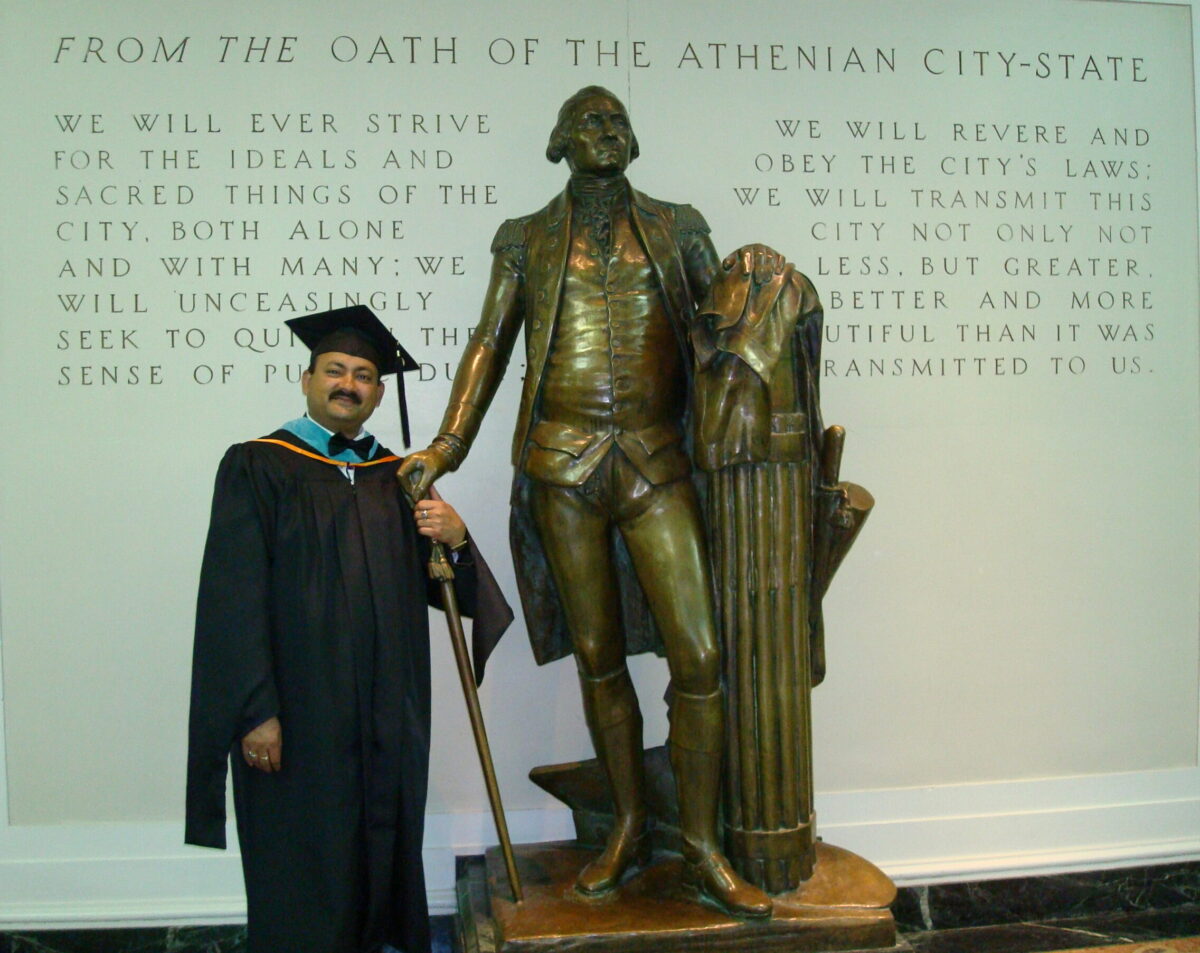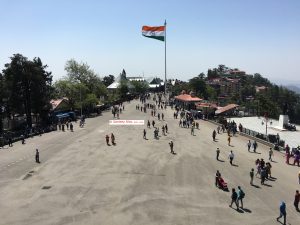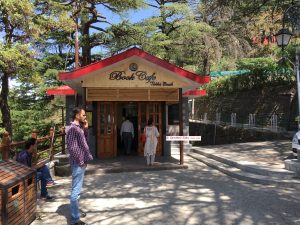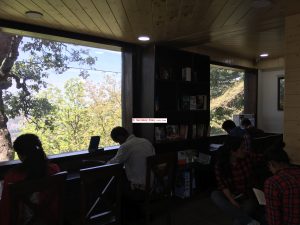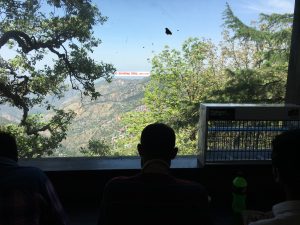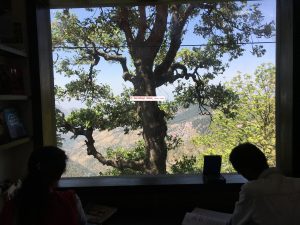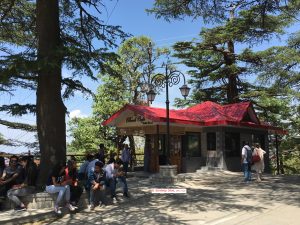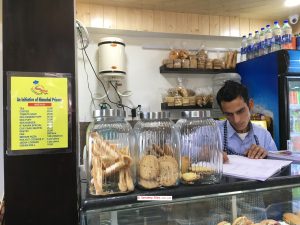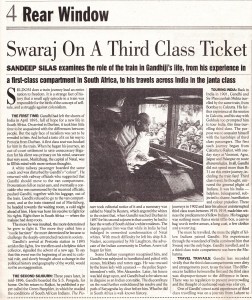Address of Sandeep Silas delivered in the distinguished presence of Hon’ble Union Home Minister, Government of India, Shri Rajnath Singh, at RIM event, Vigyan Bhavan, New Delhi on January 15th 2019 !
Tag: Reforms in Governance
Communication…lesson from the avian world ! by Sandeep Silas
Clear #communication and shared #vision is the key to #success!
#Management lesson from the avian world!
https://youtu.be/6HP8T3kaxsQ
Usta Kaam…gold finger on camel back ! by Sandeep Silas
Bikaner, had been successful in evoking may images in the past in my mind; the temple where rats run like devotees, the grandeur of the Junagadh Fort Palace; Lalgarh palace splendor; Gajner palace and the serenity of its lake; the sharp shooter Karni Singh, erstwhile royal of Bikaner, and a somewhat blurred image of gold work on camel leather.
I enquired and set off to search for this Usta Kaam, name I learned later, and stopped by at some small dusty, clumsy shops, where creativity was at its best in humble surroundings. The flawlessness of the work stood out in sharp contrast to the scratches on multi-purpose work cum display tables.
Behind the counter stood a thin young man carrying the burden of legacy despite its odds. He was born in the community of Usta’s, who were originally from Multan, now in Pakistan, and had migrated to Mughal Court. The then Raja of Bikaner, Rai Singh invited them to Bikaner to work on the Junagadh Fort and Anup Mahal walls and ceilings. Naqqashi, is also known as gesso painting and what the craftsmen did to the Raja’s Fort and Palace is nothing short of being miraculous. Delicate floral and animal forms in resplendent gold have left the palace still looking like a decorated bride about to be wed.
Later on, the Usta’s shifted their work to be executed on camel leather as in declining kingdoms and later Independent India there were no royal courts to patronize their work and provide sustenance. The process though appearing simple is very painstaking. First the camel hide is softened and stretched and then placed on clay moulds. To remind you of the strength of camel hide, it was used to make saddles for horseback warriors and shields in war! The mould is removed after drying it for two days in the sun. Then the craftsman draws lines of the design he is going to make on the piece. The items can be in different shapes, like wine flasks, with long or short stem as the case might be; goblets; vases; perfume containers; water-bottles; jewellery boxes, lamp shades, picture-frames; wall hangings; and mirror-frames!
Akbara, is the technique of the design process, wherein a paste of powdered bricks, animal fat, jaggery and fenugreek seeds is embossed on the surface. The coloured portions are first painted and then outlined with fine black lines. Then the glamorous green and red colours are applied on the item and finally a coat of chandras, local varnish seals the fate of the beauty!
Kamladevi Chattopadhyay elaborates the process thus, “The portion to be ornamented is raised by repeatedly applying a special preparation of shell powder, mixed with glue and a kind of wood apple. Alternatively, sand from a ground earthen pot is mixed with glue and jaggery to create the required paste. The embossed surface is then painted upon. Usually a colour called paveri is applied first. Then a colour made from sindur and rogan is applied. Rogan is prepared by mixing chandras and linseed oil. Bat is applied to area where gold is to be patched.
Mohammad Haneef Usta distinguishes between different kinds of Naqqashi:
- Golden lacquered Naqqashi, in which flowers and leaves are golden
- Golden lacquered Naqqashi with mina, in which colour is applied to flowers and leaves
- Golden lacquered Zangali, in which the work surface is emerald green and rest in different colours
- Golden lacquered Tantla, in which surface is golden while flowers and leaves are in colour, and details are in white
- Ranga Baijee in which the work surface remains white, flowers and leaves are painted in transparent colour and partly shaded
He further clarifies on motifs:
- Turanj, in which identical patterns are transcribed at the base and the top
- Chande, in which a small and intricate design is repeated all over the decorated area
- Bharat, in which the entire surface is filled with motifs and patterns leaving little visible “
The most popular patterns are called Tarabandi; star-studded sky and, Naqqashi; floral and animal patterns!
Before the families practicing and nourishing this art are forced to abandon it for want of poor network and appreciation in international markets, the society or a start-up should think of ingenious ways to reach this rare art to markets and museums of the world! It is a gift of God!
Unable to curb my urge to possess one such piece I requested Javed, an artisan to make me a wall hanging with the profile of a famous Rajasthani princess in the centre portion…like she is sitting in a chhatri and waiting for her lover with longing in her mystic eyes!
Note: All photographs have been shot in the natural environment of an artist’s workshop !
The #Oriental White-eye by Sandeep Silas
I photographed the #Oriental #White-eye in my garden today. It hardly settles down for a fraction of a second. Here, in some photographs the bird can be seen drinking droplets of water from jasmine leaves. Sharing the beauty !
“The Oriental white-eye (Zosterops palpebrosus), is a species of white-eye in the Zosteropidae family. It is a resident breeder in open woodland in tropical Asia, east from the Indian subcontinent to Southeast Asia, extending to Indonesia and Malaysia. They forage in small groups, feeding on nectar and small insects. They are easily identified by the distinctive white eye-ring and overall yellowish upper-parts. Several populations of this widespread species are named subspecies and some have distinctive variations in the extent and shades of yellows in their plumage.This bird is small (about 8–9 cm long) with yellowish olive upper parts, a white eye ring, yellow throat and vent. The belly is whitish grey but may have yellow in some subspecies”. (http://animals.wikia.com/wiki/Oriental_White-eye)
To be with Nature is to be in Nature!
May 18th 2017
Book Cafe, run by prisoners, at Shimla, India- a reform step; article by Sandeep Silas
In a country of 1.311 billion, 1401 prisons with 4,19,623 prisoners, divided into convicts and under-trials, only one officer has had the courage and sensitivity to recognize that prisoners too are fellow human beings.
True, some Court has sat in Judgment upon them for committing some crime or the other, but do we ever come to know of their real life stories, the actual circumstance, which compelled their impulse to do an act, which was adjudged as crime under a code of law. True, crime needs punishment and the latter is necessary to maintain a discipline in a civil society, but reform is also a possibility.
This opportunity has been realized by a distinguished Police officer posted in Shimla, (Himachal Pradesh) as Director-General (Prisons), Mr. Somesh Goyal, who incidentally is also a dear friend and a batchmate.
One officer Pankaj Raj conceived the idea of a Book Café, and Somesh Goyal executed it to be located at Takka Bench, just above the famous Ridge of Shimla, which is being run by prisoners, all serving a life sentence. Here, they serve pizzas, burgers, biscuits, tea, coffee and the usual stuff inside a Café, which has wall cabinets all around stuffed with books.
Montaigne says, “Ordinate conduct, moderation, constancy apart, I believe that anything at all can be done, even by a man who, taken overall, is lacking and deficient. That is why the wise men say that to judge a man properly we must principally look at his routine activities and surprise him in his everyday dress”.[1]
The atmosphere created is of a library café, where one can sit head down immersed deep in the world being unveiled by the book and occasionally look up through the windows far into valleys and beyond, into the realms of the mind…
The Book Café was inaugurated this April 11th by the Hon’ble Chief Minister of Himachal Pradesh, who also must be given credit for approving such a pioneering venture as a first in any State of India. The Café seats 40, and has free Wi-Fi. I liked the indoor décor of deodar wood, which gives a warm feeling in a hill city. A lot of books, available to a reader, narrate the history of the evolution of Shimla, which became the capital of the British Raj, with evocative photo prints. Apart from that you have historical philosophies, detective thrillers and travel & tourism books.
I saw many young couples and the recently married ones come to the café and for want of space inside sit in conversation upon the seating area around the majestic tree outside. Having completed my walk of 7.5 km for the day, I thought I could afford a pizza and had one. The courtesy with which I was served is worth mentioning.
Look into the faces and eyes of Yograj and Jai Chand and you will wonder why life made them captives of a criminal impulse and why their life is not like other men. Just for a second of indiscretion they got punished with a life sentence, live in jail as condemned persons, devoid of fresh air, freedom to go anywhere or to eat their heart’s desire. I don’t know the facilities inside the jails in Himachal, but from what I have seen they will be definitely sub-human. I do not have those X-ray eyes, which spiritual Masters possess, blessed with the ability to look deep into your soul, but, definitely I have a feeling heart and a thinking mind. So I don’t know for sure what thoughts a prisoner of fate like Yograj has as he serves the public here, but I saw he was thoughtful.
“I disclaim those incidental reformations based on pain. ‘God must touch our hearts’. I Samuel 10:26. Our conscience must emend itself by itself, by the strengthening of our reason not by the enfeebling of our appetites. [2]
I think that if other States of India could adopt this reformatory idea as ‘sharing of best practices’ a window of reform shall open quietly, inside hearts and our society.
Prison Statistics, India
|
Courtesy: World Prison Brief; http://www.prisonstudies.org/country/india
[1] Michel De Montaigne; The Complete Essays; On virtue; page 799; Penguin.
[2] Michel De Montaigne; The Complete Essays; On repenting; page 920; Penguin.
#Award & #Public #Felicitation at #Agra, India
On February 19, 2017, the Maratha Sewa Sangh and Backward Minorities Front (non-political) organized a Public Felicitation Ceremony at AGRA (India) on the occasion of Shivaji Jayanti and conferred the Bharat Gaurav Samman (Pride of India Award) for remarkable and outstanding public service in governance!
First public award in hometown Agra !
These lovely people forever changed my concept of a public felicitation…
Reminded of the Song- Ye public hai, ye sab jaanti hai, ye public hai….. (The people know it all, nothing escapes their eyes!
The spirit behind the public service front, Shri Jitendra Yadav ji- a grassroot leader of exceptional energy, admirable conviction, and commitment to public service! People like him spend their lifetime making and changing India!
JAI HIND !
Today is #International #Day of #Peace…make a #Garland of #Peace!
On September 21, 2009 my original and innovative idea “GARLAND OF PEACE- Declare War Ruins As Peace Heritage Sites“, was launched and dedicated to the world by Hon’ble Minister of Labour & Employment, India, Shri Oscar Fernandes.
A video of the Launch Ceremony follows:
News and Views:
https://www.maxwell.syr.edu/SandeepSilas.aspx
http://www.garlandofpeace.com/photographs_launch_ceremony.php
http://www.garlandofpeace.com/genesis_idea.php
http://www.garlandofpeace.com/expert_says.php
http://www.garlandofpeace.com/related_news.php
I recall my Professor Mr. Steve Lux, Director, Executive Education Program at Maxwell School of Citizenship & Public Affairs, Syracuse University, New York, USA telling me, “Sandeep, this is an idea worth living a lifetime!”
Professor Catherine M. Gerard who serves as Associate Director of Executive Education Programs and Director of the Program For the Advancement of Research on Conflict and Collaboration at Syracuse University’s Maxwell School of Citizenship and Public Affairs, my favorite Professor, encouraged me on this path and supports the idea with full enthusiasm. She says,”The Vietnam generation is out, the second world war generation is almost out. The time for this idea has now come.”
I would also like to acknowledge Louis Kriesberg, Maxwell Professor Emeritus of Social Conflict Studies Professor Emeritus of Sociology and Associate Program for the Advancement of Research on Conflict and Collaboration who started me on the work of building peace bridges between nations and communities.
Professor Dr. Michael Tomlan, Graduate Chair of Historic Preservation, Cornell University had invited me to deliver a talk on Garland of Peace at Cornell.
Dr. Kapila Vatsayayana, a renowned international expert on culture and Member UNESCO Committee on Heritage, told me in a conversation after watching the presentation: “You are attempting to change the memory of war, the human cognition. I am with you. Run to the Prime Minister and request him to take it to the UN. The moral prestige of India will reach the heights of Swami Vivekananda days.”
Ms. Bhaswati Mukherjee, former Permanent Representative of India to the UNESCO writes: “The proposal is interesting and innovative and closely linked to conflict resolution, peace education and peace building. These issues would need to be discussed among interested delegations in the UN General Assembly in New York.”
I remember in Syracuse I was fondly called the Garland of Peace Man!
My website www.garlandofpeace.com stands for global peace and requests all citizens of the world who crave for world peace to participate and transform it into an international peace movement.
I invite all lovers of peace to kindly participate in this peace movement, visit the site and write comments on the Peace Wall.
Please nominate such sites from your countries on the Nomination page as you think are deserving to enlarge the garland of peace!
Together we can make a difference!
How long do we wait for peace…?
Please visit www.garlandofpeace.com
#Memories from the #September of 2003! #First-ever #Commemorative and #Currency #Coin on ‘#Railways in India, made by Sandeep Silas!
#Memories from the #September of 2003! #Finance #Minister, #India, Shri Jaswant Singh and #Minister of #Railways, India, Shri Nitish Kumar had released the #First-ever #Commemorative and #Currency #Coin on ‘#Railways in India’ in its entire 163 years history so far!
Idea, design and making by Sandeep Silas!
September 1st, 2003!
Some pictures to bring those moments alive!
 Sandeep Silas speaking at the Commemorative & Currency Coin Release Ceremony!
Sandeep Silas speaking at the Commemorative & Currency Coin Release Ceremony!
 Hon’ble Minister of Railways Shri Nitish Kumar delivering his Address! Proud to have served under you Sir! Truly, you are a visionary, great, fair & impartial administrator with a sound grip on the system! A statesmanlike person who respects his talented officers and works as an exemplary team leader! You taught me many important lessons of life, Sir!
Hon’ble Minister of Railways Shri Nitish Kumar delivering his Address! Proud to have served under you Sir! Truly, you are a visionary, great, fair & impartial administrator with a sound grip on the system! A statesmanlike person who respects his talented officers and works as an exemplary team leader! You taught me many important lessons of life, Sir!
 Hon’ble Finance Minister of India, Shri Jaswant Singh addressing the audience!
Hon’ble Finance Minister of India, Shri Jaswant Singh addressing the audience!
 The Release of the Commemorative & Currency Coin!
The Release of the Commemorative & Currency Coin!
First-ever on ‘Railways in India’ in its entire history so far!
Civil servant, travel writer and poet Sandeep Silas strings a garland of peace, write-up in THE HINDU Oct 21, 2009
Civil servant, travel writer and poet Sandeep Silas strings a garland of peace
The Hindu covered the Launch ceremony of “Garland Of Peace” idea and initiative on October 21, 2009

Link:
http://www.thehindu.com/features/friday-review/art/peace-strings/article36681.ece
http://www.thehindu.com/multimedia/dynamic/00008/22dmc_sandeep02_jpg_J_8895g.jpg
The recently concluded photo exhibition by Sandeep Silas at the India Habitat Centre propagates war ravaged sites of the world to be united in a “Garland of Peace.”
Each country of the world has hidden its war wounds for reasons of disgust, shame and hurt national pride.
He feels that so classified war ruins and sites can create a powerful movement for peace amongst all nations.
Images of Hiroshima and Pearl Harbor on the same platform along with sites like Lion Hill, Waterloo, Belgium; Menin Gate in the town of Ypres, Belgium; the Auschwitz concentration camps; Anzac Cove, Turkey; Fort Siloso in Singapore; Bridge on the River Kwai, Thailand; St. Paul’s Church, Ambala, India; the Berlin Wall, Germany, and the Bamiyan Buddhas, Afghanistan, were on display as reminders of past wars. Quotes and thoughts of Gandhi and Nehru on peace and war were thought provoking.
Let there be peace
Silas belongs to the rare group of crusaders whose formidable asset is the cerebral world of ideas. Such is his ability that the ideas grow faster than grass and thought in layers, as enumerated in the Yaksh Prashna put to Yudhishthir in the Mahabharat.
The idea is to declare war-ravaged world sites and buildings as peace heritage sites.
The concept “Garland of Peace” is to string these ruins and sites into a garland of peace building, peace education, peace tourism and peace activism having a lasting influence on present and future generations — the leaders of tomorrow.
To delve further, Silas suggests formation of a peace heritage committee by the United Nations with the objectives of identifying the ruins, preserving them, and putting into place a mechanism to develop these sites as the property of the world community, as the indifference and neglect of the nations gives rise to feelings of revenge and hate towards the aggressor.
The esoteric idea may emerge in a form that seems formidable, but already the impossible has been made possible. The Wailing Wall at Jerusalem is worshiped by the Jews and the Muslims. Similarly in India, Kurukshetra, the battleground of the epic Mahabharata, is a place of pilgrimage to understand the futility of war and learn the essence of the Gita.
Silas, while following the doctrine of the Gita, i.e., do your duty without expecting the reward, has tasted the fruits of his ideas.
As a civil servant, travel writer, poet, he has successfully implemented the concept of a mobile science exhibition on rails in 2003.
“Discover India by Rail” (Sterling publication), “Morrows Face” and “Borrows in the Mist” are significant contributions to the world of poetry. Recently the Sri Lankan government has accepted his suggestion of a Sita-Ram heritage tourism trail in Sri Lanka for the promotion of tourism.
Life is beautiful
Now busy with his novel concept, “Garland of Peace”, he feels that life is beautiful and unique, and let there be no “apocalyptic third war”. Torture, atrocities and humiliation are natural consequences of war, and by wearing the “Garland of Peace” he resolves to prevent war.
With his thought-provoking concept, he has already been well received by stalwarts such as Karan Singh, Kapila Vatsayan, Martand Singh (INTACH) and his alma-mater, the Maxwell School, New York.
Keywords: Civil servant, travel writer, Sandeep Silas, photo exhibition, India Habitat Centre, Garland of Peace, Hiroshima, Pearl Harbor, war, apocalyptic third war.
